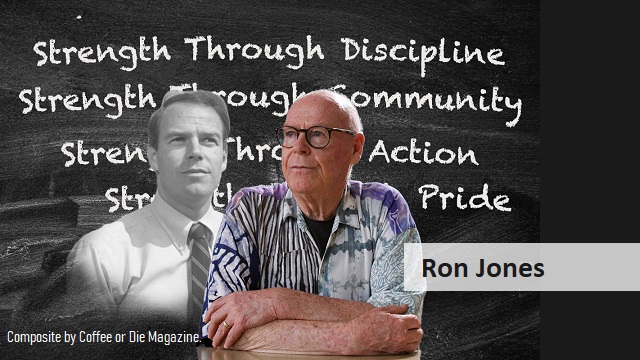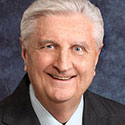Did a History Teacher’s ‘Third Wave’ Nazi Social Experiment Go to Far?
By Save America Foundation

Foreword by Fred Brownbill. I read this article which had in truth been sent to me by a extremely good and close Jewish friend of mine, a former Israeli Army Special Force operator. I read it and found it answered a few questions many may ask. I hope you enjoy it. I will post the link at the bottom of the blog as there are pictures etc. you may want to see.
Did a History Teacher’s ‘Third Wave’ Nazi Social Experiment Go to Far?
By Lauren Coontz | May 14, 2022
“Strength through discipline! Strength through community! Strength through action! Strength through pride! Strength through insight!” students at Cubberley High School chanted at a rally led by history teacher Ron Jones in April 1967. It was the last day of a classroom social experiment in which Jones, who taught contemporary world history at the California high school, attempted to teach his students about the perils of fascist totalitarianism.
Before initiating the experiment, Jones lectured his class on the shameful history of the Holocaust. The horrified students asked questions typical of children first learning of the atrocities: How could the German people stand by and watch as the genocide unfolded? Did no one oppose what was happening?
Jones — popular among students for his unusual teaching methods — had an idea for an experiment. He would replicate 1930s Germany by fostering a sense of entitlement among some of his students, while ostracizing others. The 2010 documentary Lesson Plan interviewed Jones and his former students, who gave first-person accounts of their experience.
On the first day of the experiment, Jones entered the classroom and wrote “strength through discipline” on the chalkboard. Jones lectured the students on the merits of disciplined adherence to a routine and asked the students to sit up straight. When answering questions, Jones directed students to stand and be as concise as possible with their answers. On the second day, Jones added “strength through community” to the chalkboard, lecturing on the benefits of working together as a team and building community spirit.
Jones labeled his new movement the “Third Wave,” relating it to how surfers ride only the third waves, known to be the strongest. He taught the students a salute — a cupped hand raised next to the head, the elbow bent at a right angle.
Jones then passed out index cards to act as proof of membership in the Third Wave, noting that anyone who received a card with a red X on the back was now an informant. These randomly selected students, whom Jones sometimes referred to as Gestapo, reported anyone who acted contrary to the Third Wave’s community values.
In Lesson Plan, former student Sherry Tousley remembers asking Mr. Jones, “Why can’t we just say what we think?” Jones banished Tousley to the library. He continued to send other students who questioned the movement to the library. When Tousley told the librarian, who’d grown up in Nazi Germany, her reason for not being in class, the librarian expressed alarm. She told young Tousley, “You can’t take this sitting down; you have to do something.”
Tousley and her father secretly began to place anti-Third Wave posters in the school’s halls. Within an hour of school’s starting the next day, the posters were already removed. Tousley named her library-banished revolutionaries “The Breakers.”
By the third day, Jones wrote “strength through action” on the chalkboard. He lectured about the merits of activism and asked students to begin recruiting others outside the classroom. “Strength through discipline and strength through community mean nothing without action to go with it,” former student Philip Neel recalled in Lesson Plan.
As the days passed, Jones noted his own growing enjoyment of the power, the control, and the students’ adoration during the experiment. He liked having 100 students salute him in the hallways.
“That’s pretty addictive,” he says in Lesson Plan.
The experiment began to take on a life of its own, and by day three, Jones was holding mock trials in the classroom from informant testimonies. Because of the student Gestapo, members of the Third Wave couldn’t trust their best friends; some of them had known each other for more than 10 years. Fights broke out in the hallways over membership status and differing opinions on Jones’ unorthodox teaching methods.
On the fourth day, Jones added “strength through pride” to the chalkboard and told the class the Third Wave was real. He explained it was a national movement to save the country from the Democrats and Republicans who could not agree on policy or how to get the country out of Vietnam. The impressionable students believed their young, charismatic, and trusted leader.
Jones then informed the class of a rally the next day for Third Wave members only, during which the new national leader behind the movement would reveal himself through a television broadcast to more than 1,000 participating high schools.
On the day of the event, photographers swarmed the auditorium — mostly friends of Jones whom he’d asked to pretend to be press. Jones stood at the front with around 200 students eagerly waiting for him to speak.
“Let us show everybody the extent of our training,” Neel remembered Jones saying.
“We all stood up at attention and belted ‘Strength through discipline; strength through community, strength through action,’” Neel said. “It started soft, and it grew louder and louder and louder.”
Jones turned the little 19-inch television on and left the room with only the snow crackling on the screen. The photographers and Jones, along with his self-appointed student bodyguards, then left the room.
“It was like a pressure cooker. We all felt like something was really wrong,” former student and producer of Lesson Plan Mark Hancock remembered.
Some students ran from the auditorium.
“I half expected those doors to be locked,” former student Steve Coniglio said. “I tore out of there,” Hancock added.
The lights came on and Jones approached the front of the room, looking disturbed. One student yelled, “There is no national leader!”
Jones, in response, snapped to a “Sieg Heil” Nazi salute and played clips of the 1933-1935 Nazi Party rally films from Nuremberg.
“What I have witnessed has really sickened me,” Neel said, remembering Jones’ speech as the realization dawned on the students.
Jones recalled telling the students, “We are no better or worse than the Germans. We are just like them.”
The repercussions of Jones’ experiment served as the inspiration behind a feature film, a theatrical production, a Netflix miniseries, an Emmy Award-winning 1981 after-school special, and two documentaries — in both English and German. The case study is often used as an example in schools to showcase the pitfalls of totalitarianism and the ease with which a civilized society can turn on itself. The experiment’s official website includes study guides and lesson plans to help teachers caution their students about the dangers of totalitarianism.
Jones has since acknowledged the danger he created in conducting the experiment. Though he advocates learning about it, he warns teachers against its implementation.
©Lauren Coontz. All rights reserved.
RELATED ARTICLES: Biden Admin Plans To Roll Back Trump-Era Free Speech Protections In Education

This article is courtesy of DrRichSwier.com, an online community of citizen journalists, academics, subject matter experts, and activists to express the principles of limited government and personal liberty to the public, to policy makers, and to political activists. Please visit DrRichSwier.com for more great content.

